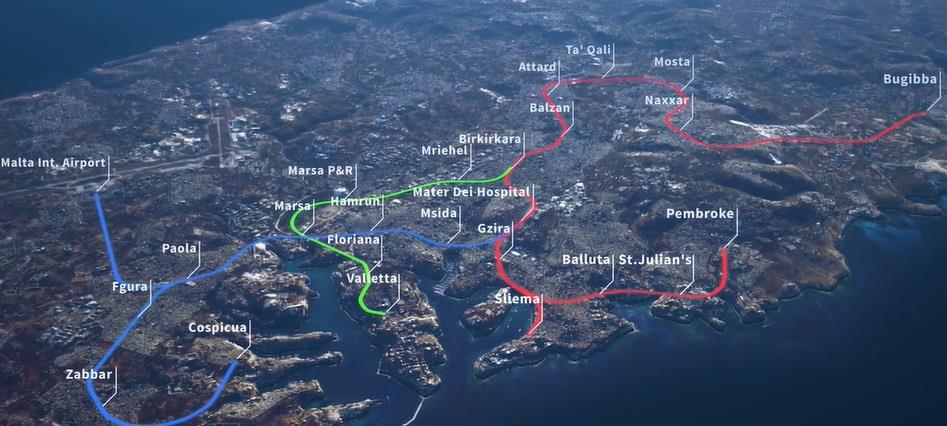The government on Saturday evening published the results of a study which deals with the possibility of having an underground system in Malta.
The metro system as proposed will include three metro lines with a total of 35km of tracks and 25 stations across Malta's main urban area. The study suggests that the metro system will mostly be underground, with a small part of it above ground between Naxxar and Bugibba.
The metro is estimated to cost around €6.2 billion to build in a time span of between 15 to 20 years, with €3.9 billion for a first phase to be delivered after between five to eight years.
A cost-benefit analysis indicates that it will return €1.40 for every €1 spent, primarily due to reduced journey times.
It will reach as far as Bugibba in the north and Cospicua in the south, with a stop at the airport too.

A red line will take passengers through localities such as Naxxar, Mosta, Attard, Birkirkara, Sliema and St Julian's, with a stop also at Mater Dei Hospital, a blue line will go through Paola, Fgura, Hamrun and Marsa while a green line will include Valletta, Floriana and Mriehel. There will be intersections for passengers to cross over from one line to another.
There will also be shuttle buses to areas such as San Gwann and Luqa, the study suggests.
Gozo will not be reached with the metro as the study concluded that a population increase of 50,000 in Gozo would be necessary to make the link viable.

The study was carried out by Arup Group, a London-based design, engineering and planning firm.
Prime Minister Robert Abela said that a cousultation exercise will follow the study, giving everyone the chance to put forward ideas about the project.
The financing of the project would also need to be discussed, and the private sector could play an important part in its implementation, he said.
Infrastructure minister Ian Borg said the idea behind the study was to launch a discussion on the project, including aspects related to its cost and the time it will take to complete.
He said the proposal would span multiple legislatures to truly plan for future generations.

He said that such a project could be considered after efforts were taken in hand to improve the existing road network.
Transport Malta CEO Joseph Bugeja said the study considered various mass transport options to come up with a system that was efficient, affordable and sees to the people’s needs.
The proposed design, he said, was very much in line with others in cities which have a similar size to Malta’s.
Donald McDade from Arup said the system will seek to reduce car usage and thereby cut down on traffic congestion. It will mean there could be more space for recreation, greenery and parks, while reducing air pollution.
The system would therefore reduce Malta's carbon footprint and promote a healthier lifestyle with more physical activity.
Other options considered, such as a tram and elevated monorail, would have had too much of an impact on existing transport networks, negative visual impacts, and will not sufficiently serve historic and hilly areas.
The proposed underground system will use twin tunnels dug 10 to 12 metres below street level. Excavated material will be reused for land reclamation.
A website with full details of the proposal can be found at www.metro.mt
Preview video
In a statement, the PN said it welcomed the publishing of the studies conducted by international experts regarding a metro solution for Malta.
We continue to believe that efficient and affordable mass transport is a must for Malta. We encourage all stakeholders to make their voices heard in this process to ensure the best outcome possible, one that benefits users all over the country and finally combats Malta’s traffic problem, the PN said.